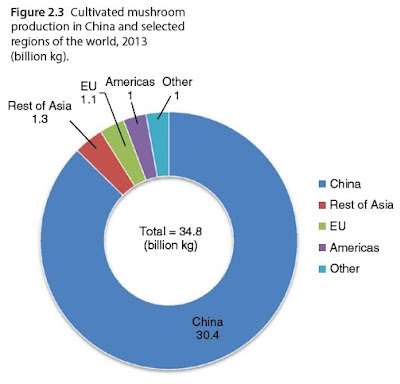
Economics of Mushroom Production: Kennett Square and the Rise of China
Mushrooms are a relatively small US agricultural crop, with total production of about $1.2 billion in the 2017-2018 growing year. But they do illustrate some economic lessons, including how a local area that develops a specialization in a certain product can be hard to dislodge, and how the rise of China is reshaping global production in so many ways.
US mushroom production has for a long time been very geographically concentrated. The town of Kennett Square in southeastern Pennsylvania bills itself as the Mushroom Capital of the World, because about half of all US mushroom production happens in the surrounding area of Chester County.
The story here goes back to 1885, and to a florist named William Swayne who lived in Kennett Square. Swayne grew a lot of carnations, which required raised beds. He pondered whether it might be possible to grow a cash crop in the space under those raised beds. Mushrooms had been domesticated in France and England in the middle of the 19th century. Swayne sent away to England for mushroom spores, and began growing them. The demand was high enough that he built a "mushroom house," an enclosed building designed to grow only mushrooms. Other local farmers took note, and the Mushroom Capital of the World became established.
From an economic point of view, an obvious question is why mushroom production remains so concentrated in Chester County more than 120 years later. After all, the basic materials for growing mushrooms like compost from vegetative material (like straw and hay), along with animal manure, are not hard to find. The climate of southeastern Pennsylvania provides a usefully cool ground temperature in fall, winter, and spring, but there are many other locations with similar temperatures.
But from the perspective of global mushroom production, this sixfold increase in US mushroom production in the last half-century is only a modest part of the story. The growth of China's economy has led an extraordinary rise in global mushroom production in the last 20 years. Daniel J. Royse , Johan Baars and Qi Tan provide background in "Current Overview of Mushroom Production in the World." which appears as Chapter 2 in the 2017 book Edible and Medicinal Mushrooms: Technology and Applications, edited by Diego Cunha Zied and Arturo Pardo-Giménez. As they note (references omitted):
World production of cultivated, edible mushrooms has increased more than 30‐fold since 1978 (from about 1 billion kg in 1978 to 34 billion kg in 2013). This is an extraordinary accomplishment, considering the world’s population has increased only about 1.7‐fold during the same period (from about 4.2 billion in 1978 to about 7.1 billion in 2013). Thus, per capita consumption of mushrooms has increased at a relatively rapid rate, especially since 1997, and now exceeds 4.7 kg annually (vs 1 kg in 1997; Figure 2.2). ...
China is the main producer of cultivated, edible mushrooms (Figure 2.3). Over 30 billion kg of mushrooms were produced in China in 2014, and this accounted for about 87% of total production. The rest of Asia produced about 1.3 billion kg, while the EU, the Americas, and other countries produced about 3.1 billion kg.
Here's a figure showing growth of mushroom production vs. world population.
And here's a figure showing global mushroom production by location:
For sales of fresh mushrooms within the US and Canada, Kennett Square doesn't appear to be under immediate threat. But a 2010 report of the US International Trade Commission pointed out that the US became a net importer of processed mushrooms--typically grown in China--back in 2003-2004.
A version of this article first appeared on Conversable Economist.
Trending
-
1 UK Tech Sector Secures a Third of European VC Funding in 2024
Azamat Abdoullaev -
2 France’s Main Problem is Socialism, Not Elections
Daniel Lacalle -
3 Fed Chair Jerome Powell Reports 'Modest' Progress in Inflation Fight
Daniel Lacalle -
4 AI Investments Drive 47% Increase in US Venture Capital Funding
Felix Yim -
5 The Future of Work: How Significance Drives Employee Engagement
Daniel Burrus







Comments